Wildlife home range – our custodial role
Monday, January 14th, 2013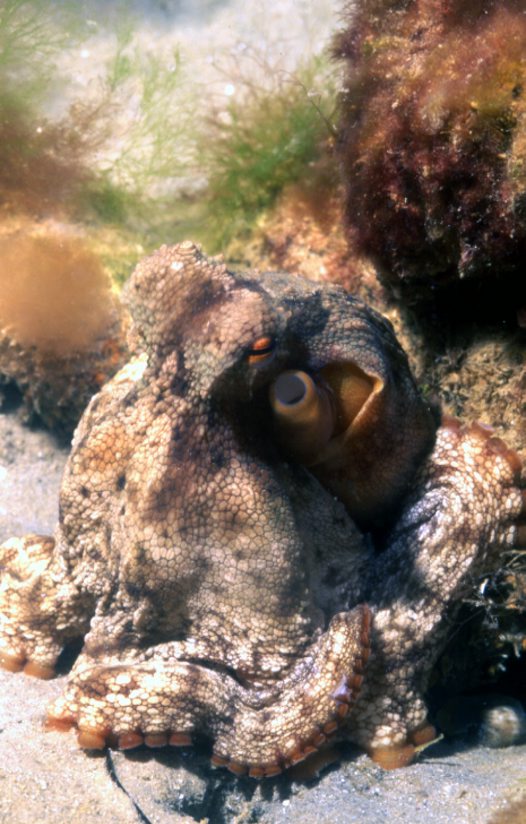 Common Sydney (‘Gloomy’) Octopus (Octopus tetricus)
The familiar octopus at Wylie’s Baths (ocean pool), Coogee would have probably looked like this.
But a Randwick Council cleaner has killed him and his marine habitat and other marine life by using toxic chlorine bleach.
[Source: Photo © Kevin Deacon, ^http://australianmuseum.net.au/Common-Sydney-Octopus]
Common Sydney (‘Gloomy’) Octopus (Octopus tetricus)
The familiar octopus at Wylie’s Baths (ocean pool), Coogee would have probably looked like this.
But a Randwick Council cleaner has killed him and his marine habitat and other marine life by using toxic chlorine bleach.
[Source: Photo © Kevin Deacon, ^http://australianmuseum.net.au/Common-Sydney-Octopus]
.
Common Wildlife Derided
.
They want to stop labelling species as “common” like the “Common” Wombat. Many once ‘common’ wildlife species like the Koala, Thylacene, Platypus are either extinct or approaching extinction due to Humanity’s dismissive common treatment, disrespect and slaughter.
Many wildlife species with the word ‘common’ in their name: Common Brushtail Possum, Common Ringtail Possum, Common Wallaroo are mostly treated with common contempt as if vermin. Look at Lenah Meats of Launceston in Tasmania. Common Possum and Common wallaby are native wildlife but are being poached for butchering, fur and profit. Lenah claims it is a company with “a deep ethical position“…operating from “a climate change perspective“. ^http://www.lenah.com.au
.
The intrinsic value of ‘Home Range’
.
Many species of wildlife are territorial. It does not so much mean that they are aggressively territorial, as modern society has come to interpret the word ‘territorial’, but that the wildlife adopt a ‘Home Range‘. They live, feed, breed within that home range, because Nature has endowed sufficient food richness and sanctuary to enable them to survive in an ecologically sustainable population. Territorial wildlife that are forced outside their home range, generally die. Deforestation and large bushfires do this. The cumulative impact is regional extinction, particularly given that much wildlife habitat has long been reduced to remnant disparate islands barely large enough to sustain territorial wildlife populations.
Similarly, when people live in a place for a while, they become more acquainted, familar, fond and attached to the place. They get to know the local characteristics, habits, patterns, and idiosyncracies of a place that are particular to that place. Their knowledge about the place deepens to an insight and a local wisdom and this instils affection and a sense of belonging to the place and an empathy and custodial, if not parental, responsibility for its inhabitant creatures and their habitat. Personal attachment to a place is the when a place becomes valued as a home. One’s home is not just a roof over one’s head. It is the immediate surroundings, connections and amenity – the Human Home Range. The place becomes ‘special’.
A home and a home range hold personal value and over time, one’s daily life, lifestyle and home and home range become intertwined. This naturally engenders a need to preserve and protect the place almost in a territorial sense, because without it one’s own daily life and lifestyle values are impacted. After all humans are animals and have derived common primordal instincts and behaviours.
And so it is wholly understandable that when external harm impacts upon one’s home and home range, response is powerfully emotive and vocal because the sense of loss is personal and soulful.
This month’s tale about the killing of the local Wylie’s Baths Octopus may seem to outsiders to be a relatively ephemeral case in point. But what matters is the impact on people and their home and on wildlife and their home. Another example could equally apply to BP oil covered Pelicans along the Lousianna coast, firestorms and tempest that have ripped through human and ecological communities. It is about a place that has become special and this is revealed in the emotive way the tale is told and the feelings expressed by locals.
.
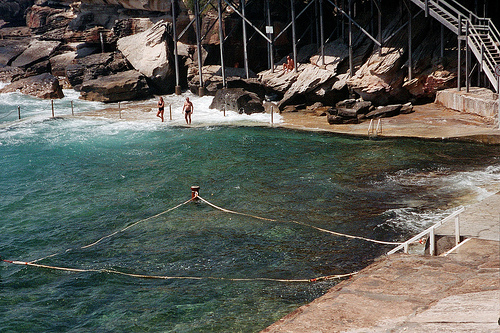 Coogee’s historic Wylie’s Baths, Sydney’s seaside pool at Coogee since 1907
Coogee’s historic Wylie’s Baths, Sydney’s seaside pool at Coogee since 1907
.
<<It was an unusual whodunit: a much-loved octopus found dead at Coogee’s historic Wylie’s Baths. But it did not take long to find the likely perpetrator – an overzealous cleaner armed with chlorine.
”I’ve been swimming there for 11 years and I’ve never seen anything remotely like this,” said Coogee resident Matthew Martin who described the scene at the tidal bath as a ”dead sea”.
Wylies Baths Coogee.
”Not only was every marine fibre bleached white and dead, so was every marine creature that usually lives in the pool.”
The Wylie’s Baths Trust, which runs the site, has posted a mea culpa on its website about the death of its resident octopus ”apparently as a result of chlorine contamination”.>>
.
<<As you may be aware, very regrettably our resident octopus recently died, apparently as a result of chlorine contamination in the pool. Chlorine has been used to clean the pool surrounds for many years. It is a necessary function of our duty of care to manage serious slip hazards caused by the build-up of marine growth.
The success or otherwise of the cleaning process is a complex issue, dependent upon many factors including frequency, volume, timing, tide, temperature and swell. It appears in this instance, we got it wrong.
Wylie’s Baths Trust and Management are engaging Randwick City Council and the EPA on the matter and will be reviewing our pool cleaning procedures as part of the investigation. We look forward to patrons ongoing support in our endeavours to maintain the pristine, safe and natural Wylie’s Baths environment we all hold so dear.>>
.
[Source: Wylie’s Baths Trust, website notice, January 2013, ^http://www.wylies.com.au/wylies-cleaning.html].
<<The notice said the ”success or otherwise of the cleaning process” – to routinely remove slip hazards posed by algae growing around the pool – was dependent on a range of factors including ”frequency, volume, timing, tide, temperature and swell”.
”It appears in this instance, we got it wrong,” it said.
But that was not enough for Randwick City Council, which said the pool must come up with another cleaning method to prevent slip hazards at the baths.
Although some Sydney councils use chlorine or another algicide to do this, all pools cleaned by Randwick – including the neighbouring ladies’ baths – are cleaned using a hot-water pressure system.
”We are committed to safe maintenance practices which do not harm our local marine life,” a council spokeswoman said.
A spokesman for the trust, Tony Cousins, said it had asked the Environmental Protection Authority to help it review its cleaning.
”If there’s a good option for us to use other than chlorine, we’ll be dead keen on using it, I can assure you,” Mr Cousins said.
But he said he did not think the incident had stirred lingering disquiet about management changes last year, which were part of an attempt to make the pool more financially sustainable.
Regular swimmer Fiona Giles said the mishap was ”arguably a direct result of the communication problems that persist” at the site.
Wylie’s had recently returned to cleaning the pool with chlorine after using grit and a bristle brush proved ineffective.
Sydney Institute of Marine Sciences director Peter Steinberg, a professor at the University of NSW, said the effect of chlorine on marine life was localised and short-term, but its use had ”diminished significantly in recent years”.
”It’s frowned upon by the agencies that worry about those kinds of things,” he said.
Work was ongoing to develop non-toxic wax coatings to control algae, he said, but other experiments using small grazing snails have been abandoned.
”It was difficult to corral the snails in the end,” he said.
A Coogee local, Reg Chappell, said management might have made an error cleaning the pool. But he and fellow regular swimmer Sam Camer said the marine life – which in the past has included bream and a Port Jackson shark – would return with the tide. Less conventional methods have been deployed in the past to clear Wylie’s of unwanted marine visitors: a persistent wobbegong was once hurled back into the sea by its tail.
”We threw him over the corner, but then he just came back in again,” Mr Camer said.>>
.
[Source: ‘Wave of protest as chlorine kills Wylie’s resident octopus’, by Leesha McKenny, Urban Affairs Reporter, Sydney Morning Herald, 20130113, ^http://www.smh.com.au/environment/animals/wave-of-protest-as-chlorine-kills-wylies-resident-octopus-20130112-2cmhf.html].
Watch Octopus retreat from Human
[Source: Australian Museum, (let’s not hope that this is where they end up), ^http://australianmuseum.net.au/Common-Sydney-Octopus-Octopus-tetricus].
.
.
Clovelly’s ‘Bluey’ Legend
.
This month’s tale about the killing of the local Wylie’s Baths Octopus at Coogee compares with a previous tale just a few beaches up at Clovelly about the killing of a well known Blue Groper fish affectionately known by many locals simply as ‘Bluey‘.
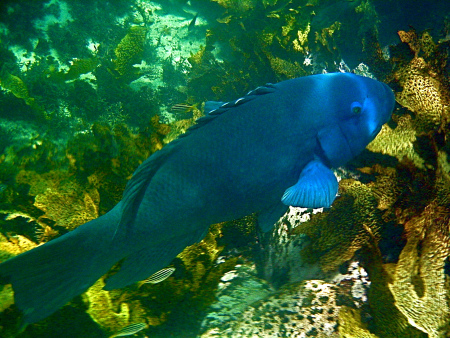 Clovelly’s much loved Blue Groper – a gentle giant
(Eastern Blue Groper – Achoerodus viridis)
[Source: ^http://regainingparadise.wordpress.com/category/clovellys-blue-groper/
Clovelly’s much loved Blue Groper – a gentle giant
(Eastern Blue Groper – Achoerodus viridis)
[Source: ^http://regainingparadise.wordpress.com/category/clovellys-blue-groper/
.
“In the old days (1940’s and 1950s) my friends and I used to be able to go to Rottnest (Perth’s holiday island) and spear a boat load of dhuies (best fish around). These days there’s nothing there – I don’t understand it.”
~ 85 year old veteran Western Australian spear fisherman Maurie Glazier quoted by niece Jo Buckee 20040908.
.
2005
.
<<Outraged beachgoers have accused divers of spearing one of Sydney’s friendly, much loved blue gropers at Clovelly Bay, a repeat of the “murder” of a similar fish which sparked a public outcry three years ago.
NSW Fisheries and Randwick Council (Sydney) are investigating claims that two men emerged from the water with a 1.5-metre spear and a mesh bag containing a female groper at about 9.30am on Sunday.
In 2002, the then premier, Bob Carr, expressed outrage at the killing of a groper at Clovelly which was initially thought to be Bluey – an inquisitive fish which was something of a local character.
Sam Zahedi, a member of Clovelly Surf Club, was among those who remonstrated with the divers involved in Sunday morning’s incident.
“I saw two men come out of Clovelly baths – both of them had diving suits on,” he said.
“One had a spear about five-and-a-half feet long and one had an underwater bag with a groper in it.” He said the fish had the distinctive yellow and grey-brown colouring of female gropers.
Kelly Stevens, a spokeswoman for NSW Fisheries, said: “We have had a report of this incident and we are investigating.”
A council beach inspector spoke to the men about spearfishing, although it is unclear whether the officer saw a groper.
Gropers are a cherished element of Sydney’s sea life and are famed for their tame behaviour. The coast between Bronte and Coogee is an aquatic reserve and killing gropers carries a fine of up to $11,000.
Among their fans is Mr Carr, who enjoys snorkelling at Clovelly and who described those responsible for the 2002 death as “mongrels”. It later emerged that Bluey was still alive and that the victim had been another groper.
Geoff James, president of Clovelly Surf Club, said that any attack on a groper would be deplored by local people: “All the members of Clovelly Surf Club and the Clovelly community abhor any such event or practice. The gropers are part of the unique nature of our little beach and community.”
.
Gentle Giants
- The blue groper has been the official fish of NSW since 1996.
- Known to snorkellers and divers for their fearless, inquisitive nature, the fish can grow to 1.2 metres long and have distinctive large eyes.
- Gropers are born female, with a grey-brown colouring. Some turn into bright blue males later in life.
- They are natives of Australian waters and largely found between southern Queensland and Wilson’s Promontory, Victoria.>>
.
[Source: ‘Beachgoers scream blue murder at fish killing’, by Andrew Clark, Sydney Morning Herald, 20051122, ^http://www.smh.com.au/articles/2005/11/21/1132421603546.html].
2008
.
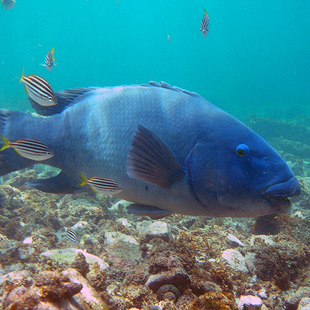 Clovelly’s iconic Blue Groper
[Source: Credit: Sylvain Dubey,
^http://sydney.edu.au/news/sobs/1699.html?newsstoryid=4257]
Clovelly’s iconic Blue Groper
[Source: Credit: Sylvain Dubey,
^http://sydney.edu.au/news/sobs/1699.html?newsstoryid=4257]
.
<<He’s probably Sydney’s favourite fish, popular with tourists and locals alike – even though nobody’s really sure if he’s still alive. Bluey – the eastern blue groper that was thrust into the public spotlight when it was “murdered” at Clovelly Bay in 2002 – is somewhat of a local character.
On January 22 that year, the Courier published an article titled ‘Appeal to find groper killer‘, after it emerged that a spear fisherman was seen holding a metre-long groper.
“Bystanders saw the young man emerge from the water with the groper still alive and watched as he bashed the fish with a diver’s knife,” the report read.
Locals were outraged and the then premier Bob Carr, a close friend of Bluey, described his killer as “a mongrel”.
A week later, in the Courier’s January 29 issue, it seemed the tide had changed for Bluey.
“Stop nailing that coffin,” journalist Andrew London wrote, as he explained of how two readers, both avid scuba divers, claimed the Clovelly fish was not the groper killed.
Fred Angles of Randwick said he had fed Bluey after the spearing incident and reckoned the fisherman killed one of the smaller female gropers in the area.
“Bluey is huge,” Mr Angles said in the report. “There is no way he could have paraded Bluey on his spear because he is so heavy.”
Phew! Bluey was still alive, and his legend would live on.
Then in November 2005, outraged beachgoers accused divers of spearing another groper at Clovelly, but this one was definitely a female, so it seemed Bluey was off the hook once again.
All gropers are born female, with a grey-brown colouring, and some turn into bright blue males as they age.
Greg Towner, a diving instructor for Deep Six Diving, said at least two blue gropers were seen regularly at Clovelly, and about four or five frequented the area further out to sea near Shark Point.
“They are pretty much everywhere along the Sydney coastline, but you can be reasonably sure that Bluey is still there [at Clovelly],” he said.
But Clovelly surf club captain Alan Kane said it more was likely that the fish which swimmers, snorkellers and scuba divers call Bluey is another blue groper.
“The name ‘Bluey’ seems to get passed down a fair bit,” he said. “Where the original Bluey is, I’m not too sure, but there’s a bit of a hand-me-down arrangement to whoever is the dominant blue groper at the time.”
Whether or not the true Bluey is still nibbling on the toes of swimmers at Clovelly is not that important, Mr Kane said.
“We love our Bluey,” he said, “and lots of people from all over the place come out to see him, so we think they love him, too.”>>
.
[Source: ‘Bluey lives on’, by Menios Constantinou, The Southern Courier (Sydney eastern suburbs newspaper), 20081020, ^http://southern-courier.whereilive.com.au/news/story/bluey-lives-on/].
Says John Rowe of Clovelly/Gordon’s Bay:
“I’ve been diving at Gordon’s Bay since 1965. I’m a big supporter of the aquatic reserve. It just gives people an opportunity to interact with wild animals and I believe that enhances their life. Because they also get a better appreciation of their environment. Nothing’s going to give me greater pleasure than my grandchildren are old enough to take them for a dive and introduce them to Bluey. And I think that would be just a wonderful thing.”
[Source: ‘Blue Groper’, Catalyst Programme, ABC TV, 20100225, ^www.abc.net.au/catalyst/stories/2830467.htm]
.
2012
.
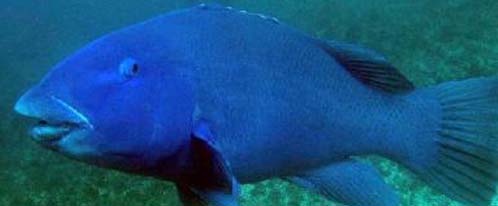 [Image: ^diving.abyss.com.au]
[Image: ^diving.abyss.com.au]
<<Bluey’s back. Or is he?
The legendary Clovelly Bay groper, famed for befriending many a Sydney snorkeller, may have returned. Or he’s spawned a family.
Intriguingly, the new Bluey on the block could also be a female that has changed sex and simply replaced him, a phenomenon characteristic of the eastern blue groper species.
Bluey was thrust into the spotlight in 2002, when he was “murdered” by an unknown spear fisherman. So loved was the fish, the then NSW premier Bob Carr called the killer ”a mongrel”, before announcing five new aquatic reserves near Sydney beaches to protect marine life.
”I have seen the groper,” the premier pronounced at the time. ”I have swum with him. I know the groper, he was a friend of mine.”
But then a year or so later, Clovelly swimmers sighted Bluey, sparking debate on whether rumours of his death had been greatly exaggerated. And this summer a large bright blue dominant male has been spotted.
A Coogee Pro Dive scuba master, Evan Batten, confirmed a Bluey lookalike was in the area, but said it was impossible to verify whether it was the original. Such sightings are so regular Mr Batten calls Bluey the ‘Elvis of the Sea‘.
”Bluey is definitely a legend, he was extremely large, 1.2 metres long and a very rich blue. But did he get killed? Was it really Bluey they speared? Maybe he escaped and now has come back?”
To John Rowe, the secretary of the Gordons Bay Scuba Diving Club, Bluey is ”the Phantom”, named after the comic-strip character who never dies. While he was a long-time fan of Bluey, Mr Rowe said no one knew when the legend began ”especially because when the dominant Bluey dies a dominant female becomes the new Bluey,” he said.
All eastern blue gropers start life as greenish-coloured females, though some will change sex and colour to become blue males.
Professor Steve Kennelly, the director of fisheries research at the Department of Primary Industries, doubts the original Bluey is still alive and suggested another fish may have simply replaced him. ”It’s safe to say a Bluey or Bluey’s relatives are back but it’s definitely not him or his son,” he said. ”I’d be very surprised if it was the original as he wouldn’t have lasted this long.”
Professor Kennelly said public outrage over Bluey’s death had helped promote a need to protect the species. It has been illegal to spear gropers since 1969 – they can only be fished with a rod and line. In 1998, the eastern blue groper was announced the official fish of NSW.
News of Bluey’s possible return excited Mr Carr.
”I snorkelled at Clovelly a few weeks ago and was happy to see a family of gropers enjoying the crystal clear water with me,” he said. ”Why anyone would spear them is still beyond my understanding.”>>
.
[Source: ‘True Bluey or not, snorkellers hail Elvis of the sea’, by Ilya Gridneff, Sydney Morning Herald, 20120115, ^http://www.smh.com.au/environment/conservation/true-bluey-or-not-snorkellers-hail-elvis-of-the-sea-20120114-1q0b5.htm].
2012 Eden (NSW South Coast)
.
<<The NSW Department of Primary Industries (NSW DPI) has fined a man for spearing four Blue Groper, which is the official fish of NSW, at Twofold Bay at Eden.
The 49-year-old man was caught as a result of a routine fisheries inspection by NSW DPI Fisheries Officers.
NSW DPI Director of Fisheries Compliance, Glenn Tritton, said there are strict rules for catching Blue Groper in NSW.
“It is very disappointing to see the illegal taking of our State emblem, especially when it has been protected from spear fishing for more than 40 years,” Mr Tritton said. “Anyone who undertakes any sort of fishing on our waterways needs to know the rules, ignorance is no excuse.
.
“NSW DPI will not tolerate the spearing of Blue Groper and penalties can range up to a maximum of $11,000.”
.
Mr Tritton said the 49-year-old man was found snorkelling, carrying a speargun, adjacent to a small inflatable boat on the southern side of Twofold Bay.
“Fisheries Officers approached the man and the small vessel and allegedly observed four Blue Groper in the boat that had wounds consistent with those made by a spear,” he said.
“When interviewed, the man admitted to spearing the four Blue Groper.”
The man was formally interviewed and was issued a $500 penalty notice on the day.
.
Fishing Rules for Groper:
.
- A recreational fishing licence must be held for all methods of fishing in NSW
- In NSW Groper can be only taken by using a rod and line or a handline
- Groper cannot be speared and have been protected from spear fishing since 1969
- Groper cannot be taken and/or sold by any method of commercial fishing
- There is a bag limit of 2 Groper per day
- There is a size limit of 30 cm (only 1 of which can be longer than 60 cm)
- People must also comply with any additional restrictions which apply in marine parks and aquatic reserves.>>
.
(Ed: It is about time the Blue Groper was respected properly as a legally protected species nationally under Australia’s EPBC Act, without having to wait for its numbers to further decline. Why should wildlife species be denied a right to ecological protection unless their numbers have become endangered? The rarity basis for wildlife protection is but base moral relativism, and exploitative convenience.)
.
<<The Blue Groper became the official fish of NSW following the death of “Bluey” at Clovelly in 2002, who was killed by an unknown spear fishermen. It is protected from spear fishing because it is so tame and inquisitive, so it is highly vulnerable to this method of fishing.
The Blue Groper presents in several different colours including blue, green, brown and red and changes sex from female to male during its life cycle. The largest specimens are males that are coloured the bright blue from which it takes its name.
Anyone witnessing illegal spearing of Groper is urged to contact their local fisheries office immediately.>>
.
[Source: ‘Groper killer caught by fisheries officers on South Coast’, by media communications officer, Alyssa Fitzgerald, New South Wales Government, Department of Primary Industries, 20120131, ^http://www.dpi.nsw.gov.au/archive/news-releases/fishing-and-aquaculture/2012/groper-killer-caught].
Ban Spearfishing!
.
Further Reading:
.
[1] >’The Impacts of Spearfishing‘, by Jon Nevill, 2006, (Word Document, 30 pages, 320kb), ^http://www.onlyoneplanet.com/marineSpearfishing.doc









